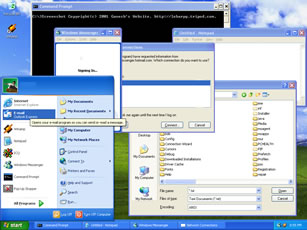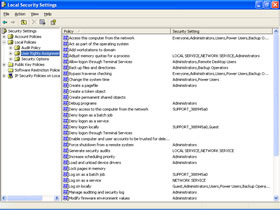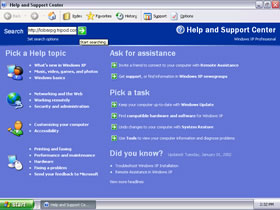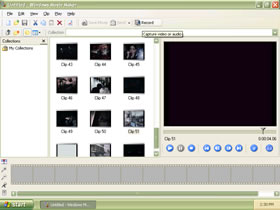
|
Review of Microsoft Windows XP Professional (48.5%
Complete)
The Past
Here I am in front of my good ol' computer, comprising
of a Pentium II 300, 256MB RAM, 20GB IBM Hard Disk,
ASUS P2B, Sound Blaster AWE64, Realtek RS8029 NIC and
a 3dfx Voodoo3 3000. Oh, and a 32X Sony CD-ROM. Do I
need to mention the floppy drive and other necessities?
Running Windows Millennium Edition, the system has
begun to give problems such as hanging on the shut down
screen, freezing at times and the impossibility of going
to Stand By mode, where if I resume from the stand by
mode, the system will freeze every 2 seconds.
The Starting Point . . .
Even with it's system requirements of a Pentium II
233, 128MB RAM, 1.5GB Space plus the necessities such
as the CD-ROM and sound card, Windows XP stood out among
the rest in some cases, and a disappointment in other
cases.
When I first got Windows XP, I was intending to install
it in my hard disk which already has Windows ME. After
going through backups and deleting windows, I discovered
that running the SETUP.EXE in the Windows XP CD gave
a shocking message "This program cannot be run
in DOS Mode". As I didn't have access to the web,
I installed Windows Millennium Edition back and installed
XP (using the New Installation option and my current
drive) over it, hoping it has the intelligence to remove
WinME completely. To my horror, WinXP Setup created
a Windows.0 folder (even though I specified C:\WINDOWS)
and installed the files to it! Maybe I was stupid .
There were some information online as I discovered later,
which enabled me to install a new copy, thanks to Google. .
There were some information online as I discovered later,
which enabled me to install a new copy, thanks to Google.
First, the Setup program. I did a clean install, if
you want to know how I did that, you can check here
- Installing Windows XP From
DOS. Windows XP didn't allow me to customise which
accessories to install. Rather, it installed all the
things I'll never use. Windows Movie Maker, Windows
Messenger, MSN Explorer and Remote Assistance (not that
I will need it, hehe). The Setup program went smoothly,
restarting my computer about 3 times. At some points,
it will request Regional Data (like time, data format)
and network information, instead of asking all these
in the beginning. This requires you to be near the PC
during setup.
After installation, Windows XP started up with the
beautiful Luna interface. Here is the full blown Windows
XP screenshot with the new interface enabled (this is
taken weeks after the installation):
 What
this Windows XP Interface Screenshot has: What
this Windows XP Interface Screenshot has:
- New interface, icons and start menu.
- Notepad, Windows Messenger, Command Prompt and the
Notepad Open Dialogue window
- Behind Windows messenger, you see the Network Connections
window. Since I have 4 ISPs (yep, four), and Windows
Messenger is attempting to connect to the server,
this window allows you to choose your connection.
Same as Windows ME dial-up window.
- Mouse pointers can have shadows and many other visual
enhancements you can disable all these visual addons
to speed up your PC.
View the screen
shot in its actual size in 1024 x 768(158 KB), for
privacy reasons, the name beside the icon in the start
menu is not shown.
The first thing that you will notice upon booting Windows
XP is the XP version of the bootup screen. It's cooler,
with a black background and the words "Microsoft
Windows XP Professional" with a small blue(green
for Home Edition) bar near the centre that goes like
Windows 2000 animation. Bootup speed was normal.
Upon launching the GUI, the desktop was sky blue with
the word Welcome. Seconds later, I am in my desktop.
 Windows
XP's key advantage is the management of multiple users.
An administrator, that is, the person who has full access
to the computer can create accounts and set certain
rights to it. Similar to Windows 2000 network management,
but in this case, it is your computer that is the network.
A user with a account can customize his Start Menu,
Desktop icons and has his own folders for Cookie storage,
Temporary Internet Files, Temporary Files, Favourites,
History and even his own Outlook Express storage area.
Users can set files to be non-viewable by other users
(I'm not sure whether Administrators can access private
files). Users can also be granted rights, in Local Security
Options. Here, you can set password minimum and maximum
age, password length, complexity requriements, password
encryption, the ability to shut down the system, set
a message text for users attempting to log on and much
much more. Windows
XP's key advantage is the management of multiple users.
An administrator, that is, the person who has full access
to the computer can create accounts and set certain
rights to it. Similar to Windows 2000 network management,
but in this case, it is your computer that is the network.
A user with a account can customize his Start Menu,
Desktop icons and has his own folders for Cookie storage,
Temporary Internet Files, Temporary Files, Favourites,
History and even his own Outlook Express storage area.
Users can set files to be non-viewable by other users
(I'm not sure whether Administrators can access private
files). Users can also be granted rights, in Local Security
Options. Here, you can set password minimum and maximum
age, password length, complexity requriements, password
encryption, the ability to shut down the system, set
a message text for users attempting to log on and much
much more.
If you have multiple users, the welcome screen will
show the user image and their userid. A person just
has to click on the id, enter his/her password and his
personal desktop can be accessed.
Windows XP comes with built-in ZIP support. Clicking
a folder in Explorer will expand to include zip files
as folders. Clicking one of the "folders",
you can view, add and extract files from the archive.
Unfortunately, some programs will not install without
administrator rights. Worse, some programs will not
even run, even if they were installed by an administrators.
Features that bring it to the front
System Restore, now, that is a good feature many people
would like to use. Microsoft's definition: "In
the event of a system problem, you can restore your
computer to a previous state without losing your personal
data files (such as documents, Internet favorites, and
your e-mail). System Restore monitors changes to your
computer, and periodically makes easily identifiable
restore points. These restore points allow you to revert
your system back to a previous state. You can also create
and name your own restore points at any time."
I didn't use this, as I don't use it that often.
For LCD monitors, XP comes with what is calls ClearTypeTM
technology. Supposedly it improves font resolution and
I've met people who liked this technology. However,
take note that it will bring no improvement to CRT monitors.
When I enabled this for my CRT monitor, all text appeared
slightly blurry, enough to hurt my eyes  .
Keep in mind that this only affects text, and will not
enhance LCD quality of images or other non-text stuff.
But it will sure make your Internet browsing better. .
Keep in mind that this only affects text, and will not
enhance LCD quality of images or other non-text stuff.
But it will sure make your Internet browsing better.
Windows XP also allows someone to remote control your
PC, similar to pcAnywhere by Symantec. This is great
if you need to friend to give you technical support.
In this case, it allows you to set whether he can control
your mouse and/or keyboard.
If you're a Internet Explorer fan, you'll be pleased
to know it comes with version 6, the current latest
version. However, there are many serious bugs in IE
5.5 to IE 6 that Microsoft has resolved in its WindowsUpdate.com
website.
 The
help system in Windows XP includes much more information
that the previous Win9x's OS's. Information on partitioning,
FAT32, NTFS, defragging and other stuff can be found. The
help system in Windows XP includes much more information
that the previous Win9x's OS's. Information on partitioning,
FAT32, NTFS, defragging and other stuff can be found.
Speaking of NTFS, Windows XP supports NTFS and it is
highly recommended you upgrade to NTFS unless
you have set up dual OS's. Windows NT and 2000 only
support NTFS. If you convert your drive to a NTFS, it
will not be accessible by unsupported OS's. NTFS offers
compression on selected folders and/or files and more
free disk space as the minimum cluster size is only
0.5kb, while FAT32 is 4kb.
If you have a CD Writer, you'll be glad to know that
Windows XP supports CD Writing. It is in some ways restricted,
such as not being able to verify if data is written.
Don't hope for it to be as full blown as Nero. First
you have to select files to write, and then issue a
command to start writing the CD.
 Finally
Windows XP comes with all the usual accessories, Windows
Movie Maker, Narrator (only includes a Male Voice called
Microsoft Sam that reads out text at the mouse pointer),
Windows Media Player 8, Fax support, Internet Connection
Sharing (if you want to share the internet connections
among your computers in the network), Internet Firewall
(blocks hacking attempts - great if you have a always-on
connection), Network Bridge (Microsoft's definition:
"The network bridge simplifies the setup and configuration
of small networks that consist of different types of
network adapters, such as wireless, Ethernet, and home
phoneline network adapters (HPNA). The network bridge
creates a software connection to link the different
types of adapters together. There is no need for special
equipment that would normally be required for communication
between different types of network adapters. Only one
bridge may exist on a computer, but it may be used with
as many different types of network adapters as the computer
can physically accommodate.") and Error Reporting
(which sends error reports to Microsoft when it occurs). Finally
Windows XP comes with all the usual accessories, Windows
Movie Maker, Narrator (only includes a Male Voice called
Microsoft Sam that reads out text at the mouse pointer),
Windows Media Player 8, Fax support, Internet Connection
Sharing (if you want to share the internet connections
among your computers in the network), Internet Firewall
(blocks hacking attempts - great if you have a always-on
connection), Network Bridge (Microsoft's definition:
"The network bridge simplifies the setup and configuration
of small networks that consist of different types of
network adapters, such as wireless, Ethernet, and home
phoneline network adapters (HPNA). The network bridge
creates a software connection to link the different
types of adapters together. There is no need for special
equipment that would normally be required for communication
between different types of network adapters. Only one
bridge may exist on a computer, but it may be used with
as many different types of network adapters as the computer
can physically accommodate.") and Error Reporting
(which sends error reports to Microsoft when it occurs).
Stability
Stability is the main issue when you plan to get an
OS. In my time with Windows XP, I've never seen the
Blue Screen of Death (also referred to as BSOD) even
once. Win9x (including ME) has not given me this kind
of treatment before, and it is that stable.
In Windows 9x, if I used my PC continuously for more
than 3 hours, Win9x will definitely hang at shut down,
which is why I had to make it a point to restart my
PC every 1.5 hours. In Windows XP, that is not the case,
and I'm very pleased about the minor convenience.
Bootup and Shutdown timings
Starting Windows XP was relatively fast, I wasn't able
to time it, but it varies among different computers.
Mine starts up within 1.5 minutes. Shutdown however,
takes longer than previous Windows OSs. Cool thing is,
the status is displayed. For example(in my case), it
first said "Closing Network Connections",
then "Saving Settings" and finally "Shutting
down Windows".
The "other" side
Getting used to XP takes some time. First, I discovered
that my external modem has to be switched on
when Windows XP boots up or else Windows XP will report
a "Port not responding" error if I attempt
to use the modem. This could be due to the Telephone
services not running, but even starting them fails.
So, whenever I had to use the Internet, my modem has
to be switched on during bootup. It can be switched
off after bootup. Call me a power saver.
Months after release, 18 Megabytes of patches are filling
up Windowsupdate.com. However, not all will apply to
you, for example, the Windows Movie Maker patch is not
needed if you don't use it.
The End
Errors? Omissions? Need Help? Know something? Post
your queries in the Windows
XP Discussion Forum.
This document is Copyright(©) 2001,2002 by G.Ganesh.
No parts may be reproduced in any other sites or pages
as outlined to Terms Of Usage.
Feel free to link to this page from your website but
do not host it over there. Visit Ganesh's
Website (http://www.bootstrike.com).
Last Updated 5th Janurary 2002
|
 |



